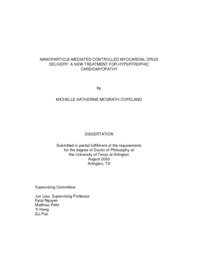
ATTENTION: The works hosted here are being migrated to a new repository that will consolidate resources, improve discoverability, and better show UTA's research impact on the global community. We will update authors as the migration progresses. Please see MavMatrix for more information.
Show simple item record
| dc.contributor.advisor | Liao, Jun | |
| dc.creator | McGrath Copeland, Michelle Katherine | |
| dc.date.accessioned | 2022-08-24T15:16:27Z | |
| dc.date.available | 2022-08-24T15:16:27Z | |
| dc.date.created | 2020-08 | |
| dc.date.issued | 2020-09-04 | |
| dc.date.submitted | August 2020 | |
| dc.identifier.uri | http://hdl.handle.net/10106/30894 | |
| dc.description.abstract | Hypertrophic cardiomyopathy (HCM) is a genetic disease of the sarcomere, resulting in overgrowth of the septum that separates the left and right ventricles. HCM can affect as many as 1/200 people, making it the most common genetic cardiomyopathy in the general population, as well as the most common cause of sudden cardiac death (SCD). In severe HCM cases, cardiothoracic surgeons perform septal myectomy to remove the excess tissue. However, many patients are poor surgical candidates and require another, less invasive treatment option. In these cases, alcohol septal ablation (ASA) is performed. With ASA, cardiologists deliver pure alcohol through a catheter to the diseased area to shrink and kill the overgrown septal tissue. However, the alcohol is not targeted to the overgrown area and indiscriminately kills both diseased and healthy cells, often resulting in complete heart block and abnormal arrhythmias that may result in the need for permanent pacemakers. To combat this clinical challenge, we have designed a novel septal ablation technique using a targeted nanoparticle drug delivery system. By targeting the diseased area, we can decrease the risks involved in septal ablation. To begin, we observed the microstructural and mechanical properties of human healthy and HCM septal tissues to better understand their properties and how these may affect our delivery system. We discovered that HCM cells have a fibrotic microenvironment consisting of excessive collagen. By targeting the fibrotic collagen, we can deliver our nanoparticle system specifically to the diseased area, thereby decreasing the likelihood of killing healthy cells. This work was accomplished in three aims: (1) Ultrastructural and mechanical characterization of human healthy and hypertrophic cardiac septal tissues; (2) Nanoparticle-mediated controlled myocardial drug delivery; (3) Regulation of the spatial distribution of hypertrophic cardiomyopathy treatments using nanoparticles. | |
| dc.format.mimetype | application/pdf | |
| dc.language.iso | en_US | |
| dc.subject | Hypertrophic Cardiomyopathy | |
| dc.subject | Nanoparticles | |
| dc.subject | Doxorubicin | |
| dc.subject | Collagenase | |
| dc.title | Nanoparticle-Mediated Controlled Myocardial Drug Delivery: A New Treatment for Hypertrophic Cardiomyopathy | |
| dc.type | Thesis | |
| dc.degree.department | Bioengineering | |
| dc.degree.name | Doctor of Philosophy in Biomedical Engineering | |
| dc.date.updated | 2022-08-24T15:16:27Z | |
| thesis.degree.department | Bioengineering | |
| thesis.degree.grantor | The University of Texas at Arlington | |
| thesis.degree.level | Doctoral | |
| thesis.degree.name | Doctor of Philosophy in Biomedical Engineering | |
| dc.type.material | text | |
| dc.creator.orcid | 0000-0002-9650-4646 | |
Files in this item
- Name:
- MCGRATHCOPELAND-DISSERTATION-2 ...
- Size:
- 2.021Mb
- Format:
- PDF
This item appears in the following Collection(s)
Show simple item record


